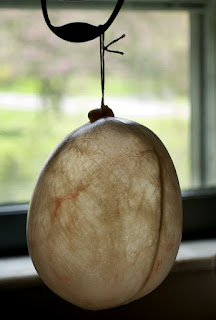 |
| Just say no, Rat (source) |
The "Placebo Effect" occurs when someone takes a functionally ineffectual drug, but feels the effects anyway. There are many examples of this: Someone in pain takes a sugar pill, but is told that it is a painkiller might report 'feeling much less pain'. A Parkinson's patient takes a sugar pill having been told it was their 'L-dopa' medication and can suddenly move more fluidly. The "Placebo Effect" is so strong that most experiments testing the effectiveness of a drug in healing anything use a placebo control. The researchers want to make sure that the drug has an actual effect that is greater than the placebo effect. (It has been proposed that homeopathic remedies are entirely due to the placebo effect)
One problem with deeply understanding the physical mechanisms which underlie the placebo effect is that all the experiments must be on humans. You can't simply tell a mouse it's getting a 'cure' and give it a fake pill. However, scientists at the National Institute on Drug Abuse (NIDA) have conducted an ingenious experiment that involves giving a mouse what is essentially a placebo. Better still, they published it in PLoS One, so everyone can read the paper for free!
Before we dive into the placebo aspect of this paper, we need to back up and learn a little about as the addiction and reward system works in the brain.
In 1954, James Olds and Peter Milner published a paper showing that a rat would press a lever to receive an electrical stimulation in certain areas of its brain.
 |
| Olds and Milner, 1954 Figure 2, Xray of rat |
Later studies found that when this electrode stimulates the dopamine system of a rat, the rat will press and press and press this lever, even forgoing food when it is famished. Incidentally, a mouse/rat will also compulsively press a lever to get injections of cocaine (which acts by stimulating the dopamine system). You can do all sorts of experiments on drug addiction using this cocaine self-injection system. You can test how long it takes the mouse to become addicted, you can test the effect of drug concentration, you can test how other drugs interact with self-injection of cocaine, and you can even test aspects of withdrawal and relapse.
Which brings up back to our placebo. Wise et al., (2008) investigated the mechanisms underlying this self-administration. What was happening in the mouse brain when they got a dose of cocaine? They found that when the mouse pressed the lever and got the cocaine there was a surge of dopamine almost immediately after. There is a center in the brain called the VTA that contains neurons which release dopamine. When these neurons are active, other areas of the brain are flushed with dopamine and the person/rat/mouse 'feels reward'. But what makes these neurons active?
This brings up a problem we discussed a while ago, about the never ending cycle of neuronal firing. The dopamine neurons fire, but why? what neurons are firing onto them to make them fire, and then, what neurons are making those neurons fire and which ones are firing before that...so forth into forever.
To go one step up in this firing-chain, Wise et al. cleverly looked at 'brain juice' in the VTA and found that when the cocaine is administered, the mouse gets a surge of glutamate there. (Glutamate activates cells, so this would cause the dopamine neurons of the VTA to fire and release dopamine onto other cells).
So what does all this mean, and how does it get us to a placebo for a rat?
Here's the thing: the surge of glutamate that stimulates the VTA only shows up in mice that have already learned that a lever press gives them cocaine. (That is, this glutamate surge doesn't occur the very first time the mouse gets cocaine)
 |
| Wise et al., 2008 (figure1B) |
Another peculiar aspect of this glutamate surge is that it is probably too fast a response to be a result of the cocaine acting in the brain. So how is the injection of cocaine causing a glutamate surge if it is not even acting on the brain yet? This is quite the puzzle. Wise et al., wanted to make sure that this glutamate surge was absolutely not due to the cocaine reaching the brain, so they invented the rat placebo! They altered the cocaine molecule, so it was mostly the same shape as normal cocaine, except it couldn't cross the blood brain barrier. That is, when it is injected into the mouse, it can be detected in the blood and in the peripheral body, but it won't be detected in the brain, and the cocaine will not be able to act directly on the neurons.
When they run the test with this molecule injected instead of cocaine, the figure looks like this:
 |
| Wise et al., 2008 (figure1E) |
So there you have it, a way to trick a rat into thinking it has just received a 'real drug' when it has actually received an ineffectual drug. I think this technique could be adapted to actually study the physiological mechanisms governing the placebo effect.
© TheCellularScale




























